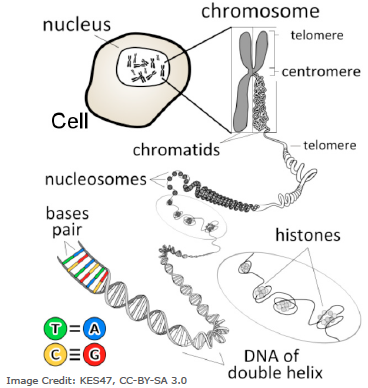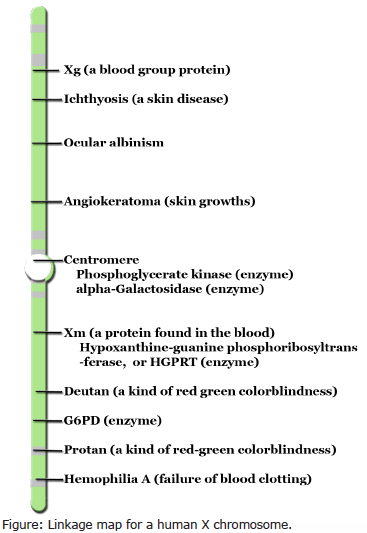Reading: A Study Guide
Big Picture
The human genome consists of all our various genes, which are the
hereditary units of our chromosomes. Humans have 23 pairs chromosomes
divided into 22 pairs of autosomes and 1 pair of sex chromosomes. Human
chromosomes are complex, consisting of various levels of organization,
and their expression determine our behavior at the molecular level.
Key Terms
Chromosome: Coiled structure made of DNA and proteins containing sister chromatids that is the form in which the genetic material of a cell goes through cell division.
Chromatid: One of two identical copies of a chromosome.
Centromere: Region where two sister chromatids are joined together.
Nucleosomes: Unit of DNA where a segment of DNA is wrapped around a histone.
Histones: Proteins that associate with DNA.
Telomere: Repeating segments of non-coding DNA at the end of each chromosome.
Karyotype: Characterizes a cell by describing the number of chromosomes and their appearances under a microscope.
Autosome: Any chromosome that is not a sex chromosome.
Sex Chromosome: Either an X or Y chromosome.
Barr Body: An inactivated X chromosome.
Allele: Variant of a specific gene.
Linked Genes: Genes on the same chromosome.
Sex-Linked Gene: Gene on the same sex chromosome.
X-Linked Gene: Genes on the same X chromosome.
Linkage Map: Shows the relative position of genes on a chromosome.
Chromosomes
DNA molecules possess different levels of organization. In its most compact form, DNA with its association of protein is referred to as a chromosome.
• The nucleosomes give the DNA and protein structure a beaded look
• Not all of human DNA codes for genes – telomeres are non-coding sequences that help prevent the degradation of the DNA during replication.

Types
Every species has a characteristic number of chromosomes. Humans have 23 pairs of chromosomes (for a total of 46).
• The last pair are sex chromosomes. There are two types of sex chromosomes called X and Y.

A karyotype shows a picture of a human cell’s chromosomes.
Genes
Humans have around 20,000 to 22,000 genes
• Most genes have two or more possible alleles
• Genes located on the same chromosome are linked genes due to their physical proximity to one another
• Genes located on the sex chromosomes are sex-linked genes
• Often times the genes are X-linked genes because the Y chromosomes has much fewer genes (X chromosome has about 2,000 genes while the Y chromosome has fewer than 100)
• Genes on the same chromosome tend to be inherited together unless crossing over happens
• Crossing over happens during meiosis I where homologous chromosomes exchange genetic material
• The closer the genes are, the less likely they will be separated by crossing-over
• The frequency a gene crosses over can be used to create linkage map - the less frequently crossing over takes place, the closer the two genes on the chromosome

